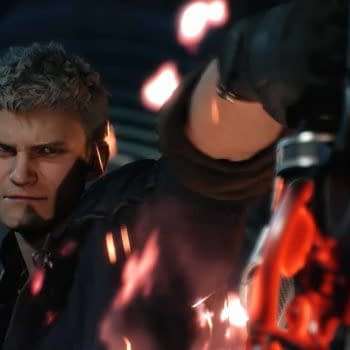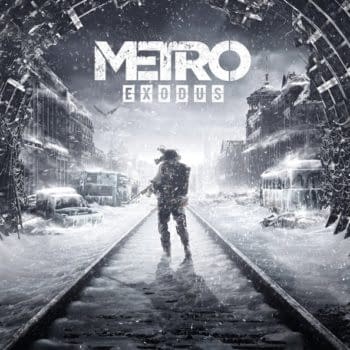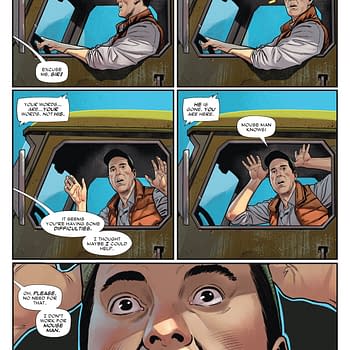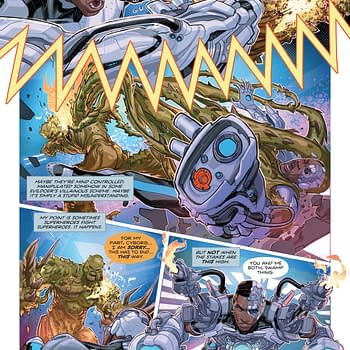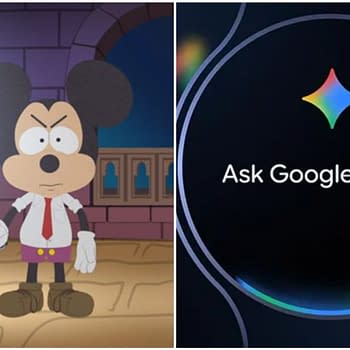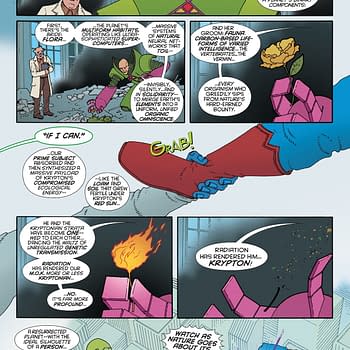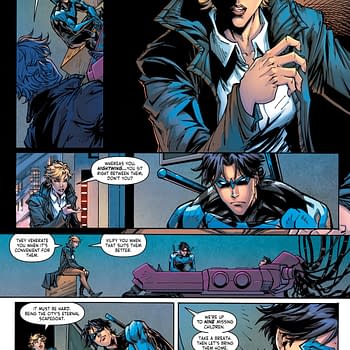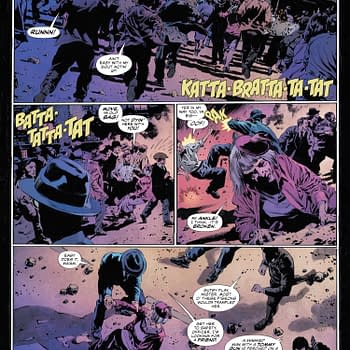Posted in: Comics | Tagged: Batman, batman and robin eternal, Comics, Robin War, Thor's Comic Review Column
Thor's Comic Review Column – Batman & Robin Eternal #1-10 And Robin Wars
THOR'S COMIC REVIEW COLUMN 12/14/15
THIS WEEK'S REVIEWS (GRAIG SAVES THE DAY!):
Batman & Robin Eternal #1-10
Robin War #1/Grayson #15
Batman & Robin Eternal #1-10 ($3.99/$2.99, DC Comics)
Robin War #1/Grayson #15 ($4.99/$3.99, DC Comics)
By Graig Kent
The fact that 2015 marks the 75th anniversary of Dick Grayson's first appearance in Detective Comics #38 seems almost an afterthought. Unlike how DC likes to highly tout the anniversaries of Superman and Batman there's no mass ad campaigns screaming "CELEBRATING 75 YEARS OF ROBIN!" It could be because there hasn't been one person in the costume all that time, so the 75 years is a bit misleading, or it could be DC wants the kids relating to the youth and vitality of Robin, and touting that he's a septuagenarian is incongruous to that image.
Regardless of how DC wants to promote (or not promote) this anniversary, they certainly haven't forgot it. Not only are there more Robin/former Robin-starring books on the stands at once than ever before, but DC's concurrently running two event books centered around the world's most notorious sidekick.
The title, Batman & Robin Eternal, is a bit of a misnomer, as it seems to imply that the dynamic duo is a forever type of deal, and this weekly series will be a celebration of that tandem. Yet, 10-issues in, at least, it's less a book focused on how Batman needs a Robin (though Bruce's misunderstanding thereof is definitely a sub-plot) but instead that, at this stage, what the Robins really need is each other. In fact, with Dick Grayson, Jason Todd, Tim Drake, Harper Row, Cassandra Cain, and Stephanie Brown all in the fold of the book so far, Eternal highlights how independent the Robins (and Batman-adjacent teen figures) really are. It's not that they can't use Batman's training and discipline but the need in that partnership isn't theirs.
The book takes place in the present environment of Batman (just don't be too much of a continuity stickler), with Bruce Wayne still an amnesiac and Jim Gordon still enveloped in Bat-bunny mech armor. It opens with a flashback of a familiar back-alley murder, but in Cairo, not Gotham. It's a purposeful scene whose real meaning has yet to be exposed, but it's certainly getting teased out in a certain direction. In the present day Agent 37, Red Hood and Red Robin converge on the same bad guy, in the process uncovering the germ of a bad guy plot over a decade in the offing. This brings them face-to-face for the first time with Cassandra Cain, and draws Bluebird and Spoiler into the mix.
Cassadra's re-appearance in the DCU comes also with the first appearance of The Orphan (a repurposed name, and a design somewhat reminiscent of Damian Wayne's evil clone brother, the Heretic). The Orphan's skills are on the level with Cassandra's, which, it's established, are as advanced as Dick Grayson's, if not moreso. The Orphan is in the service of "Mother", and is running down a checklist of Batman-affiliated names set for termination. The crux of the story revolves around team Robin's uncovering the "Mother" conspiracy, encountering legions of her brainwashed children (young and old) at every turn.
By issue ten, Eternal really feels like superhero espionage on the cinematic scale of James Bond or the Mission Impossible series. There's the requisite globetrotting as the team has divided, with Dick Grayson and Harper Row in Prague and Tim Drake teaming with Jason Todd following a lead in Santa Prisca. Meanwhile, the flashbacks from "several years prior" (I love the non-committal timeline) delve into Dick's memories of chasing the Scarecrow across the globe, unaware of Batman's related investigation into "Mother" at the same time. The flashbacks starts bringing to light Bruce Wayne's "greatest sin" and his "deepest regret" at the same time as the Robins uncover more of the conspiracy in the modern day.
The weekly series at DC over the years have been a dicey proposition. Their first big weekly effort, 52, set the bar incredibly high (to be expected when you have Morrison, Rucka, Waid, and Johns all on one book) and the success of that weekly really hasn't been repeated. The typical problem for the weekly is the editorial nightmare of juggling too many storylines among too diverse of creative teams. It seems natural, the weekly comic editor's desire to compartmentalize, giving each writer or writing team their own storyline to work on that loosely tie together in the long run, but that approach hasn't really worked since 52.
Batman & Robin Eternal seems to have taken a different tactic (perhaps learning lessons from last year's Batman Eternal weekly), and is all the more successful for it. Instead of dividing up story parts, among teams and along characters, it takes the standard weekly television series "writers room" approach. James Tynion IV and Scott Snyder act as the showrunners here, setting down the groundwork and laying out the beats, but let their writing team — consisting of Grayson's Tim Seeley, Midnighter's Steve Orlando, Catwoman's Genevieve Valentine, and Hacktivist's Jackson Lanzing and Colin Kelly — handle most of the chore of rolling the story out. It's surprisingly, and refreshingly, consistent, perhaps the most ever for a weekly comic series. The team expertly teases out the mystery while at the same time does all sorts of fan servicing by bringing forth the likes of Bane and Azrael, and putting them into the new context of modern DC comics. Best of all, the writing team seems to share the voice for these characters, with Dick, Tim, Jason, Harper and company feeling very much like defined individuals throughout.
Less consistent is the art, as is common for a weekly series. Most artists have a hard enough time handling a monthly schedule, so a weekly comic book is at the mercy of who's willing to take the gig. DC continues to experiment with how best to execute the art on a weekly, here, for the most part,they have the same team handle two issues in a row before passing it along to another team (in the past they've tried rotating teams on a monthly basis and having different teams handle different arcs within a book, all to less than middling success). Tony Daniel and Sandu Florea kicked off the extra-sized first issue (producing some really sharp work), returning again for issue 6, while Paul Pelletier and Tony Kordos handled issues 2 and 3, Scott Eaton and Wayne Faucher jump in for #4 and much of #5 (which plays out somewhat like a artist jam). Issues 7 & 8 feature the crisp shadows of Alvaro Martinez and Raul Fernandez, while 9 & 10 are mostly the beautifully clean lines of Roge Antonio (with Geraldo Borges taking the back end of #10). I do like this idea of two-straight and out, but it really only works if the artistic team can handle the workload. When the art jumps styles within the same issue it is always a jarring experience. What's more, the consistency in art styles just isn't there. For example, Daniel takes his cue from 90's Image era Jim Lee, with fine lines in place of shadows, sharp edges and lean figures, while Pelletier follows up with his heavier pen and rounded, bulkier figures. Both are great storytellers, but their styles are at odds. Eaton and Pelletier's work flow together better, as does Martinez into Antonio. Actually, despite setting the tone for the series, it's Daniel who's the oddest man out here stylistically. Having similarly styled artists in line for a weekly would probably be my preferred method of approach.
What makes Batman & Robin Eternal most interesting is the convergence of Robins (and Robin-like characters) in one story, interacting and relying upon one another as equals, highlighting their differences, and their individual strengths. It's something that's never really happened in the past, in part because one of the key Robins, Jason Todd, wasn't fully rebuilt into a useful ex-Robin until the New 52. Of course there's a glaring omission here, since we have yet to see Damian Wayne in this affair (and given the list of names presented in the first issue, it seems less likely we will, unless he's the key to bringing down this whole thing). Which brings us to DC's other big 75th Anniversary event, Robin War.
As Mikel Janin's cover of issue one so simply and effectively conveys, this story revolves heavily around the Court of Owls, but the roundness of the mask, and the wide eyes put the focus on youth rather than wisdom, and a crack down the side of the mask, with a trickle of blood around the eye intones violence for both sides. Remarkably, the Court of Owls makes only an appearance on only two (and a half) pages this whole issue, but in Grayson writer Tom King's effective hands that's all that's needed for their presence to be felt the entire issue as Gotham City Councilwoman Nocturna manipulates the media and the public into issuing a ban on teenage vigilantes (and somehow makes it seem like that's a bad thing).
Of course, the process turning teenage heroes into outlaws is a four page montage of talking heads and police busts, a rather trite, hollow, and unfortunately necessary device required to move this storyline along (as Robin War arc debuts and concludes in just over a month across the Bat-sidekick and teen-Gotham related books). There's definitely some bad going along with the good of King's script here, and vice versa. King introduces the uninitiated to the We Are Robin crowdsourced vigilante gang, making a particular splash with their foremost member, Duke Thomas, as he outsmarts a police officer and escapes a moving squad car.
The We Are Robin gang are the cause of the teenage vigilante ban and anyone caught wearing Robin colors are apprehended (there's a very thin allegory pointing to systemic oppression of teenagers and even police harassment of black youth, but looking too deeply doesn't yield any satisfactory insight into either situation) which brings Damian into the fray as he takes on a mass gathering of Robins, showing them how incapable they are before Bat-bunny Gordon breaks up the illegal assembly.
If King's script has follies they're minor, but exacerbated by the four different illustration and coloring teams the story jumps between. That some of the art presents the characters with exaggerated cartoonishness betrays the melodramatic tone of the story. Khary Randolph, for example, has a distinct style which utilizes shadows expertly, complimented well by the colors which establish a heady Michael Mann-style fluorescent glow in the botched convenience store robbery, but the exaggerated limbs and facial contortions undercut the drama of the scene. Had Randolph and the colorist (assuming Emilio Lopez base on credits order) filled out the full issue, I would have adjusted, but the artistic shifts, both in style and coloring pose a problem to storytelling flow.
Over in Grayson #15, there's absolutely no problems with King and Seeley's script, nor in Janen's art or Jeromy Cox's coloring. As happens when this team is together it's beautiful magic from start to finish.
The second chapter of Robin War finds Damian joined by the ex-Robins, Dick, Jason and Tim, together forming a "Robin school" for the We Are Robin gang. The intent of the school is not as much about training the kids as it is weeding out the incapable, the ones who are most likely to get hurt or killed. Like the thesis of Batman & Robin Eternal, there's the element of self-reliance amid the Robins, also a sense of community and family, of responsibility for each other. Though the four Robins seemingly agree that nobody can become Robin without Batman, Dick seems to understand better than the rest that it was he who shepherded Damian into the Robin role, not Bruce.
This issue provides a quartet of wonderfully structured double-page spreads from Janin showing each Robin's training technique as is individualistic to each character but also a key facet of Batman. Tim's focus is on detective work, Jason's on stealth and mischief, Damian's on aggression, and Dick's on assessing your foe while you face them, even taking a few hits to learn more about them. Meanwhile there's a mole in the team, feeding the Robins to the police and Bat-bunny Gordon, while the plot of the Court of Owls still looms, uncertain what they're really after.
Both the Robin War and Batman and Robin Eternal make a point of defining who the Robins are, and what their place is, not just in the DC Universe, and not just in Bat-history, but in each other's lives. It showcases each of them as distinctive characters, all deserving of their fans and followings but proving that there's really no perfect Robin, that the teachings and inspiration of Batman lead to all different types of heroes, not just clones of the Dark Knight. The fact that the We Are Robin group look to Robin as their inspiration, not Batman is most telling, a sign that Batman's way isn't everyone's way, and not necessarily the best way. Though I suspect it's levels, right? Being Batman means being a regular human in the most extreme of situations, somehow a titan amongst titans, yet being a Robin is a little smaller, manning the streets, bringing hope and colour to the dark shadows of back alleys. Where Batman invariably tackles the big target, Robin realizes the little things can make a difference too. Both series, by nature of having Bruce Wayne out of the picture, really capture the sense of legacy, of embracing their mentor but also moving past him. Legacy is what DC has always done well, and what the New 52 was sorely missing. With Eternal it's definitely back in full force, tickling nostalgia, while Robin War finds the legacy being even further handed down to a fifth generation.
Happy 75th Robin. You're looking good.
Graig Kent is a full blown adult with a mortgage, kids, and a wife obsessed with teen sidekicks. Her obsession is kind of infectious, and Graig now appreciates kid heroes in a way he never had before. For the record, he doesn't have a favourite Robin (but there was a time that Jason Todd was his favourite, if only because he was dead).





